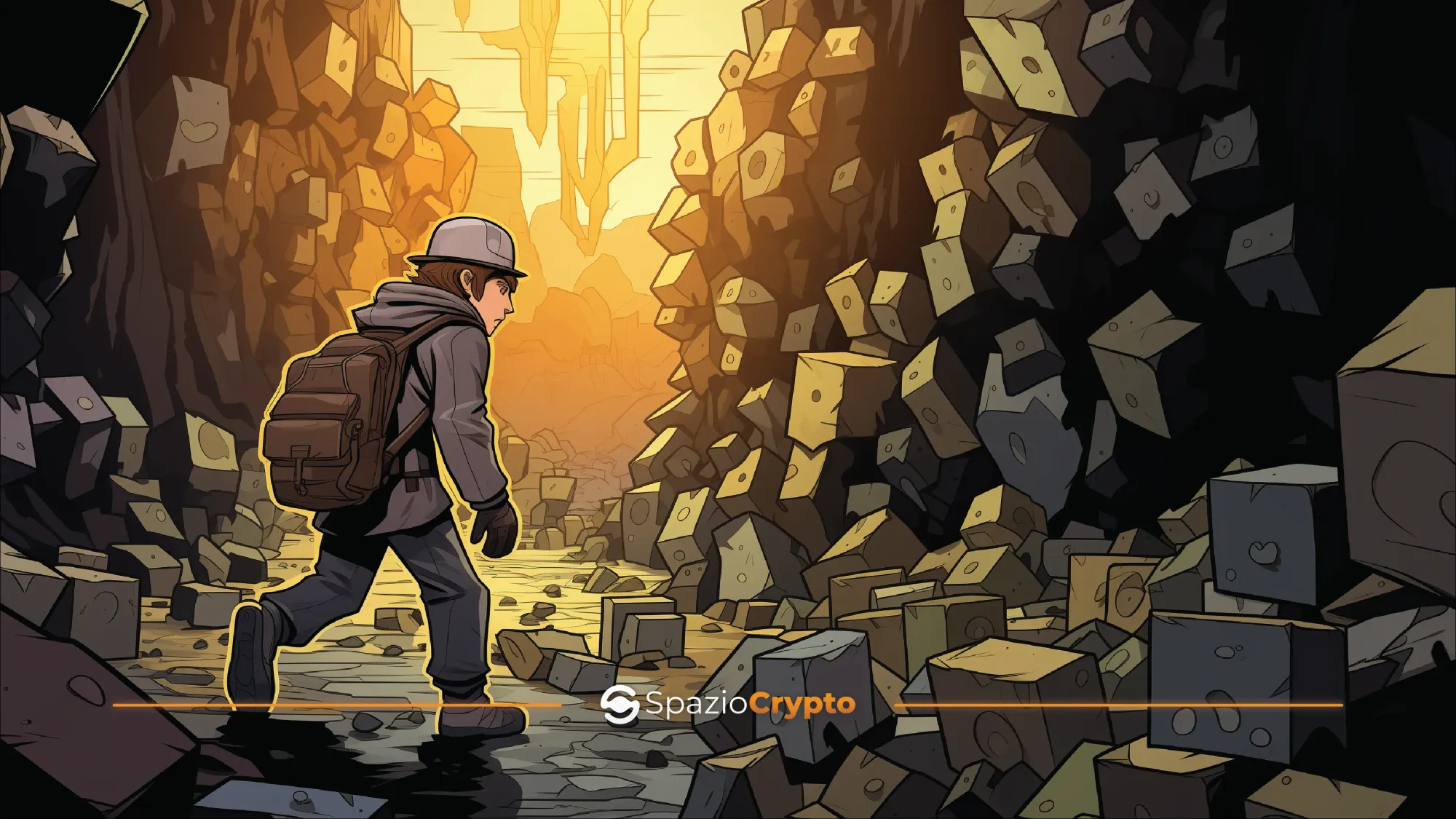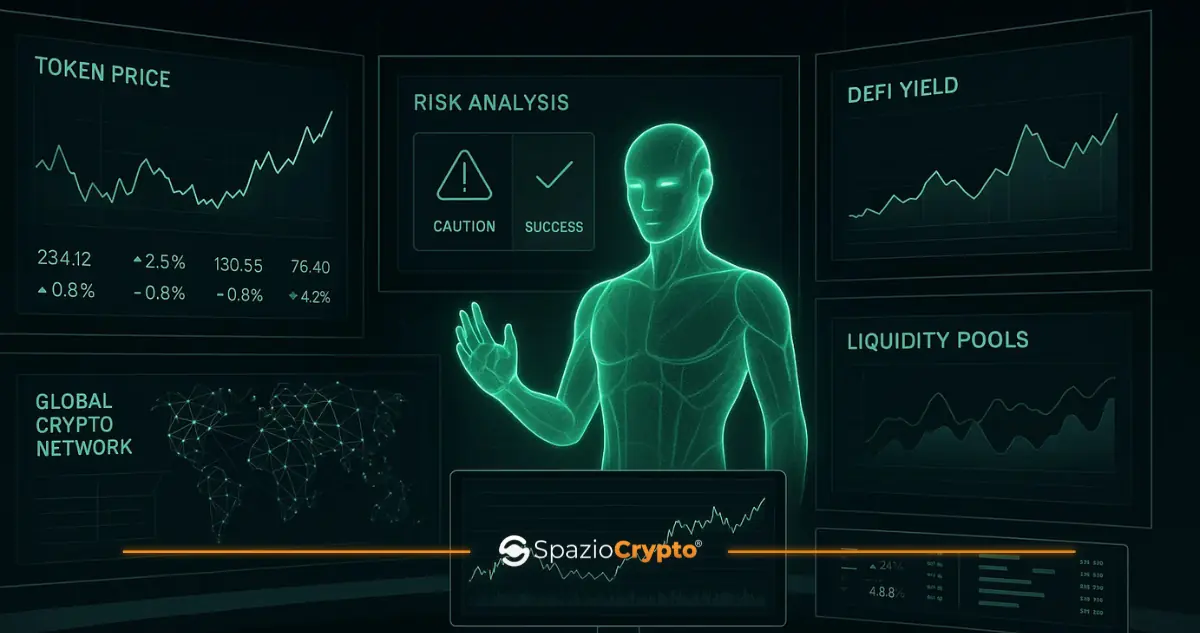In this article of Spaziocrypto's Web3 Guide we will explore the concept of the "Blockchain Explorer", a crucial tool that allows us to navigate through the depths of the blockchain, making the details of cryptographically secure transactions and blocks accessible to all. We will take a journey through the definition of blockchain, explore the fundamental role of the Blockchain Explorer and delve into its advanced functionalities. From security to privacy to future perspectives, this comprehensive guide is designed to shed light on the complex world of blockchain and its transparency through the powerful tool of the Blockchain Explorer.
Blockchain Definition
The blockchain, which began as the technology behind cryptocurrencies, has quickly gained resonance beyond the financial world. Initially known to support the operation of digital currencies such as Bitcoin and Ethereum, blockchain has proven to be much more than just a financial infrastructure. It has become the foundation of a digital revolution, with the potential to transform sectors such as supply chains, healthcare and even government. In simple terms, a blockchain is a series of securely and chronologically connected blocks of information. Each block contains a set of data, and the concatenation of these blocks creates an immutable chain. The distinctive feature of the blockchain is its decentralised and distributed nature, which eliminates the need for central intermediaries and paves the way for greater transparency and security. The basic principles are:
- Decentralisation: In a blockchain, data is distributed over a network of nodes rather than being centrally controlled. This decentralisation prevents a single actor from manipulating the system.
- Immutability: Once information is recorded in a blockchain and the chain is confirmed, it becomes virtually impossible to change it. This helps ensure the integrity of the register.
- Consensus: To add a new block to the chain, the majority of nodes must agree on the validity of the information. This process, called consensus, ensures that transactions are verified by the community.
The initial impetus for exploring the blockchain was driven by cryptocurrencies, but its reach has expanded to multiple sectors. To effectively navigate this digital world, it is essential to understand how blockchain works and, more importantly, how to access and interpret key information through tools such as the Blockchain Explorer. In the next chapter, we will explore the critical role played by these tools in illuminating the path through blockchain transparency.
The Crucial Role of the Blockchain Explorer
The blockchain ecosystem, with its decentralised structure and the vast amount of information distributed among the network nodes, requires an effective means to explore and understand the complexity of the transactions and blocks that form its foundation. In this context, the Blockchain Explorer emerges as a crucial resource, offering an intuitive interface to decipher the cryptographic language of the blockchain and make the immutable data it contains accessible to all.
What is a Blockchain Explorer?
The Blockchain Explorer is a platform, often provided as an online service or a web application, that allows users to examine and analyse in detail the information contained in the blockchain. In contrast to the opacity often associated with the world of cryptography and blockchain, the Blockchain Explorer provides a transparent window into transactions, blocks and associated addresses, making blockchain technology more understandable and accessible to a wide range of users. Key features include:
- Block Exploration: The Blockchain Explorer allows users to navigate through the blocks of the blockchain, providing key information such as the hash of the block, the timestamp of creation and the list of transactions contained within it. This allows observers to track transaction history and the progression of the blockchain over time.
- Transaction Analysis:
- One of the most crucial features is the ability to analyse in detail each transaction recorded on the blockchain. Users can examine the addresses involved, the amounts transferred and other pertinent details, enabling a complete understanding of the value stream within the network.
- Visualisation of Address Balance and Status: A key feature is the ability to verify the balance of a given address and monitor the execution status of associated smart contracts. This feature provides a clear and detailed overview of a specific address's activity on the blockchain.
- Advanced Search:
- The ability to perform advanced searches allows users to find specific information within the blockchain's vastness of data. This feature is particularly useful for those searching for specific transactions or addresses in a broader context.
Importance of the Blockchain Explorer
The Blockchain Explorer is more than just an interface; it is a key to accessing the transparency of the blockchain. Its existence democratises access to information, allowing anyone to explore and understand the evolution and activity of the blockchain in real time. It is an essential tool for developers, researchers, companies and enthusiasts, providing a clear window into the inner workings of the blockchain. We will delve further into the intricate workings of a Blockchain Explorer, revealing how these tools navigate through the network nodes to provide a detailed view of cryptographically secure transactions and blocks.
How Does a Blockchain Explorer Work?
The operation of a Blockchain Explorer is an intricate process involving sophisticated interaction with the underlying blockchain. To fully understand the crucial role of these tools, it is essential to explore how they decrypt blocks and transactions, providing a clear and detailed view of the cryptographic fabric that makes up the blockchain.
The Architecture of a Blockchain Explorer
The heart of a Blockchain Explorer lies in its ability to communicate with nodes distributed across the blockchain network. It queries these nodes to obtain information about transactions, blocks and specific addresses. This interaction occurs through an API (Application Programming Interface) that allows the Blockchain Explorer to access the blockchain's immutable data in a secure and distributed manner.
Key steps in the functioning
- Information Request: Users initiate a specific request through the Blockchain Explorer interface, indicating the block, address or transaction of interest.
- Interaction with Nodes: The Blockchain Explorer communicates with nodes distributed on the blockchain network, querying them to obtain the requested details. This interaction takes place in accordance with the communication protocols of the specific blockchain.
- Analysis and Presentation: Once the data has been received, the Blockchain Explorer analyses it and presents it in a format understandable to users. This can include interactive charts, tables and visualisations that make it easy to understand the complex relationships between blocks and transactions.
Deciphering the Blocks
Blocks form the backbone of the blockchain, and the Blockchain Explorer allows users to examine them in detail. It provides key information such as the hash of the block, the timestamp of creation and the list of transactions within it. This ability to visualise blocks clearly allows users to follow the chronological flow of transactions and understand the evolution of the blockchain over time.
Detailed Transaction Analysis
A key aspect of how the Blockchain Explorer works is its ability to provide detailed analysis of individual transactions. Users can examine the addresses involved, the amounts transferred and other relevant information. This level of detail makes it possible to trace the path of a transaction through the blockchain, providing greater transparency and security.
Advanced Uses of the Blockchain Explorer
The Blockchain Explorer, although commonly associated with transaction and blockchain searching, offers a range of advanced capabilities that go well beyond the surface. In this chapter, we will explore the advanced uses of these tools, highlighting how they can be employed for more sophisticated tasks such as forensic analysis, verification of smart contracts and more.
1. Forensic Analysis
The Blockchain Explorer has proven to be a valuable ally for digital forensic investigators. With its ability to provide a detailed view of transactions and addresses, experts can track the flow of funds, identify suspicious behaviour and assist in investigations related to illicit activity or fraud.
2. Verification of Smart Contracts
For blockchains that support smart contracts, such as Ethereum, the Blockchain Explorer is a key tool for verifying and analysing such contracts. Users can examine the source code, track the execution of transactions and ensure that contracts operate as intended, contributing to security and trust in the smart contracts ecosystem.
3. Network Health Monitoring
The Blockchain Explorer offers a detailed look at the overall health of the blockchain network. Users can monitor the number of transactions, confirmation times, address distribution and other key indicators to assess the efficiency and robustness of the network.
4. Security Audits
Companies and developers can use the Blockchain Explorer to conduct security audits on their blockchain. By analysing transactions and verifying the integrity of blocks, potential vulnerabilities can be identified and network security strengthened.
5. Pattern Research and Market Analysis
Market participants and analysts can leverage the Blockchain Explorer to identify transaction patterns, understand market flows and track the performance of cryptocurrencies. This information can be crucial for making informed decisions in the context of the cryptocurrency market.
Ethical and Privacy Considerations
It should be noted that the advanced use of the Blockchain Explorer raises ethical and privacy issues. While it provides transparency, it is essential to balance access to information with the need to protect user privacy and ensure that forensic analysis complies with applicable laws and regulations.
Security and Privacy in Blockchain Explorers
While the Blockchain Explorer presents itself as a powerful tool for exploring the blockchain, it is crucial to address the security and privacy challenges that may arise while using such platforms. In this chapter, we will take a closer look at these issues and provide suggestions on how to mitigate them to ensure safe and responsible use of the Blockchain Explorer.
Security Challenges
- Exposure of Sensitive Information: Improper use of the Blockchain Explorer could lead to the disclosure of sensitive or private information associated with transaction addresses. It is essential to be aware of this and restrict access to information only to authorised users.
- Possible Data Manipulation: In some cases, malicious users may attempt to manipulate the data displayed by the Blockchain Explorer. Platforms should implement robust security mechanisms to ensure information integrity.
- Risks Linked to Smart Contracts: Users exploring and verifying smart contracts should be aware of the potential risks associated with coding errors or malicious contracts. Careful security audits are recommended before engaging in complex contracts.
Privacy Challenges
- Traceability of Transactions: As all transactions are public on the blockchain, there is some traceability associated with the addresses involved. This transparency may raise privacy concerns, especially when users wish to remain anonymous.
- Forensic Analysis and Investigations:
- While forensic analysis may be a legitimate use of the Blockchain Explorer, it is important to ensure that it is conducted in accordance with privacy laws and that the privacy rights of the individuals involved are respected.
Tips for Addressing Challenges
- Implement Access Controls: Restrict access to sensitive information to authorised users only, e.g. by requiring authentication.
- User Education: Provide clear information to users on the importance of protecting their privacy and the responsibility associated with using the Blockchain Explorer.
- Regular Updates: Ensure that the Blockchain Explorer platform is regularly updated with the latest security patches to mitigate the risks of exposure to vulnerabilities.
- Respect Privacy: Blockchain Explorer developers and operators must be committed to respecting users' privacy and complying with data protection regulations.
It is clear that, although the Blockchain Explorer offers an unprecedented openness on blockchain, the responsible and safe use of such tools requires a continued focus on security and privacy.
Looking ahead to the future of blockchain transparency
The Blockchain Explorer, since its introduction, has revolutionised our understanding of blockchain. From a basic exploration tool, it has evolved into a sophisticated resource that supports advanced activities such as forensic analysis and verification of smart contracts. Looking ahead, we can expect further technological improvements and new features that will enrich our blockchain exploration experience. In pursuing this path of innovation, at Spaziocrypto, we are convinced that it is imperative to maintain a balance between the transparency offered by the Blockchain Explorer and the need to preserve user privacy. With the right focus on security, usability and new technologies, the future of the Blockchain Explorer promises to be exciting and full of opportunities for those wishing to navigate the depths of the blockchain.








